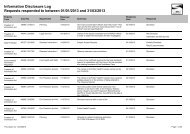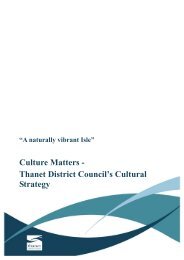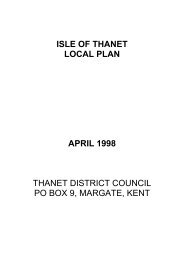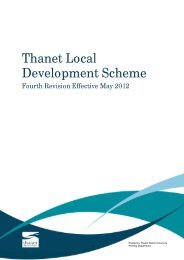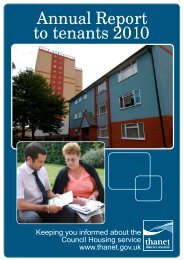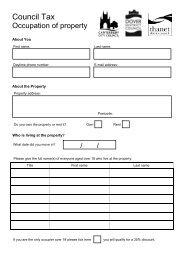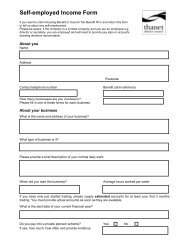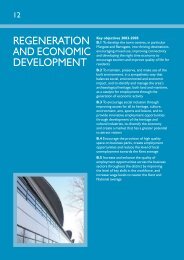Review of existing Section 106 Agreement - Thanet District Council
Review of existing Section 106 Agreement - Thanet District Council
Review of existing Section 106 Agreement - Thanet District Council
Create successful ePaper yourself
Turn your PDF publications into a flip-book with our unique Google optimized e-Paper software.
3 Noise Monitoring and Reporting3.1 IntroductionNoise is generally considered the major environmental impact in terms <strong>of</strong>pollution issues arising from the operation <strong>of</strong> an airport and its effects onexternal communities in the vicinity <strong>of</strong> an airport. As discussed in <strong>Section</strong> 6other aspects, such as air quality and surface water pollution, also areimportant items that require systematic monitoring as airport activity grows.The physics <strong>of</strong> noise measurement in the context <strong>of</strong> airports is an establishedarea, where in the past 35 years both the scientific and social effects havebeen well investigated and are understood. The state <strong>of</strong> the art in technicalstandards and equipment has been established to monitor and measure noiseimpact, which take into account many <strong>of</strong> the characteristics <strong>of</strong> the human ear.Some fundamental matters related to noise measurement will be addressed,and then the application <strong>of</strong> these to the monitoring <strong>of</strong> aviation activity will bereviewed.3.2 Noise units and measurementMeasuring the sound pressure level created by an aircraft movement is notsufficient to characterise the degree <strong>of</strong> annoyance caused. In the case <strong>of</strong>airport noise measurements <strong>of</strong> loudness undergo further calibration intendedto capture the sensitivity <strong>of</strong> the human ear, leading to what is called the A-Scale Adjustment. Thus the A Weighted decibel units are denoted as dBA.The decibel noise unit is logarithmic, so that a change <strong>of</strong> 10dBA equates to ahalving or doubling <strong>of</strong> the perceived noise. In addition, a difference <strong>of</strong> 3dBA isneeded before a difference in two noise levels can be perceived. Thelogarithmic nature <strong>of</strong> noise means than simple arithmetic averaging is notpossible, with such calculations being more complex.3.3 Aircraft noise certification and classificationIn the late 1960’s the International Civil Aviation Organisation (ICAO) and anumber <strong>of</strong> national civil aviation bodies began the process <strong>of</strong> adopting noisestandards for transport aircraft. In 1976 ICAO and the US Federal AviationAdministration (FAA) specified very similar standards that civil transportaircraft had to meet. These were set out in the ICAO Convention Annex 16 –Environmental Protection : Aircraft Noise and in the FAA Federal AirRegulation 36 (FAR 36). Annex 16 sets out a series <strong>of</strong> standards <strong>of</strong> ranges <strong>of</strong>measured noise in technical Chapters, the noisiest being early generation jets– Chapter 1 (FAR36 Stage 1), second generation turb<strong>of</strong>ans – Chapter 2/Stage2 -, and the current high ratio fan engine aircraft – Chapter 3/Stage 3.The ICAO/FAA standards set specific performance criteria for thestandardised measurement <strong>of</strong> aircraft types, relating to different aircraftmodels and variants, different engine fits and also different Maximum Take OffWeights (MTOW) for otherwise identical aircraft. The standard certificationnoise process measures noise at take<strong>of</strong>f and landing on both the landing andapproach paths and in addition to the side where take<strong>of</strong>f noise was greatest.EU00142:FINAL REPORT PAGE 9



